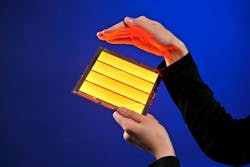Dresden, Germany--A t the Light and Building Frankfurt 2010 show (11 to 16 April), Novaled displayed what it says are efficient and long-lifetime OLEDs fabricated on metal substrates. The devices have a lifetime of up to 20,000 hours.
Metal substrates like steel or aluminum have excellent barrier properties and flexibility, and are physically robust. OLEDs on metal can be used in applications where magnetic clipping of the OLEDs is intended or where soldering, drilling, and similar assembly steps are required. OLEDs on metal are also advantageous in application where heat dissipation is critical. In addition, fabrication on a metal substrate opens the door toward low cost roll-to-roll mass production of OLEDs, says Novaled.
Together with Arcelor Mittal, Novaled has been developing OLED structures for steel substrates since 2006. In the German "Rollex" project, Novaled has contributed since 2007 in developing OLEDs on flexible aluminum substrates. "Besides demonstrating excellent results with OLEDs on glass, Novaled has developed a unique know-how on OLEDs on metal," says Gildas Sorin, CEO of Novaled AG.
The OLEDs manufactured by Novaled for luminaires and light sculptures shown at Light and Building Frankfurt are processed directly on steel plates of 0.7 mm thickness. The metal substrate requires the use of specific top-emitting OLED structures. Novaled has developed an OLED architecture that doesn't use ITO (indium tin oxide) and that reaches performances similar to standard bottom-emission structures. In addition, Novaled is developing thin film encapsulation, which will enable bendable OLEDs.

John Wallace | Senior Technical Editor (1998-2022)
John Wallace was with Laser Focus World for nearly 25 years, retiring in late June 2022. He obtained a bachelor's degree in mechanical engineering and physics at Rutgers University and a master's in optical engineering at the University of Rochester. Before becoming an editor, John worked as an engineer at RCA, Exxon, Eastman Kodak, and GCA Corporation.
